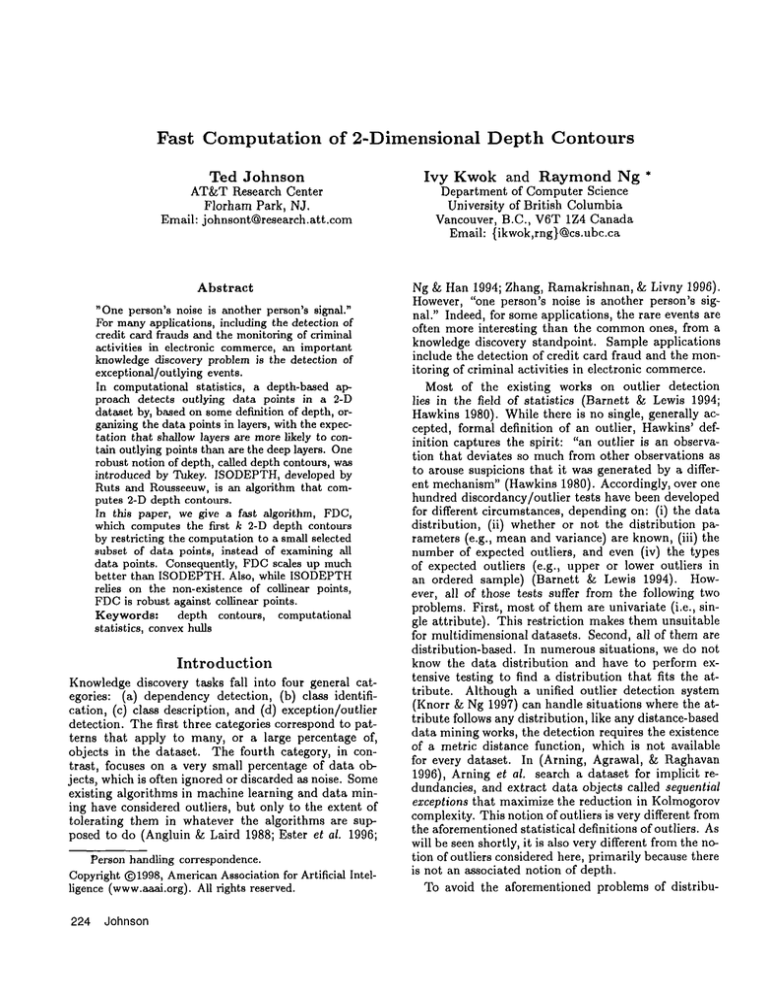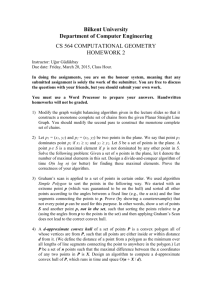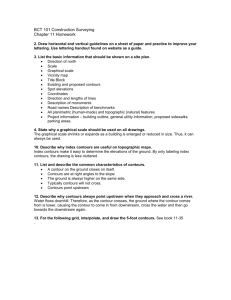
Fast Computation of 2-Dimensional
Ted Johnson
AT&TResearch Center
Florham Park, NJ.
Email: johnsont@research.att.com
Abstract
"Oneperson’s noise is another person’s signal."
For manyapplications, including the detection of
credit card frauds and the monitoringof criminal
activities in electronic commerce,an important
knowledgediscovery problem is the detection of
exceptional/outlying events.
In computational statistics,
a depth-based approach detects outlying data points in a 2-D
dataset by, based on somedefinition of depth, organizing the data points in layers, with the expectation that shallow layers are morelikely to contain outlying points than are the deep layers. One
robust notion of depth, called depth contours, was
introduced by Tukey. ISODEPTH,developed by
Ruts and Rousseeuw,is an algorithm that computes 2-D depth contours.
In this paper, we give a fast algorithm, FDC,
which computes the first k 2-D depth contours
by restricting the computationto a small selected
subset of data points, instead of examiningall
data points. Consequently, FDCscales up much
better than ISODEPTH.Also, while ISODEPTH
relies on the non-existence of collinear points,
FDCis robust against collinear points.
Keywords: depth contours, computational
statistics, convexhulls
Introduction
Knowledgediscovery tasks fall into four general categories: (a) dependency detection, (b) class identification, (c) class description, and (d) exception/outlier
detection. The first three categories correspond to patterns that apply to many, or a large percentage of,
objects in the dataset. The fourth category, in contrast, focuses on a very small percentage of data objects, which is often ignored or discarded as noise. Some
existing algorithms in machine learning and data mining have considered outliers, but only to the extent of
tolerating them in whatever the algorithms are supposed to do (Angluin & Laird 1988; Ester et al. 1996;
Person handling correspondence.
Copyright(~)1998, AmericanAssociationfor Artificial Intelligence (www.aaai.org).All rights reserved.
224 Johnson
Depth Contours
Ivy Kwokand RaymondNg *
Department of Computer Science
University of British Columbia
Vancouver, B.C., V6T 1Z4 Canada
Email: {ikwok,rng}@cs.ubc.ca
Ng & Han 1994; Zhang, Ramakrishnan, & Livny 1996).
However, "one person’s noise is another person’s signal." Indeed, for some applications, the rare events are
often more interesting than the commonones, from a
knowledge discovery standpoint. Sample applications
include the detection of credit card fraud and the monitoring of criminal activities in electronic commerce.
Most of the existing works on outlier detection
lies in the field of statistics (Barnett & Lewis 1994;
Hawkins1980). While there is no single, generally accepted, formal definition of an outlier, Hawkins’ definition captures the spirit: "an outlier is an observation that deviates so much from other observations as
to arouse suspicions that it was generated by a different mechanism" (Hawkins 1980). Accordingly, over one
hundred discordancy/outlier tests have been developed
for different circumstances, depending on: (i) the data
distribution, (ii) whether or not the distribution parameters (e.g., mean and variance) are known,(iii)
number of expected outliers, and even (iv) the types
of expected outliers (e.g., upper or lower outliers in
an ordered sample) (Barnett ~ Lewis 1994). However, all of those tests suffer from the following two
problems. First, most of them are univariate (i.e., single attribute). This restriction makes them unsuitable
for multidimensional datasets. Second, all of them are
distribution-based.
In numerous situations, we do not
know the data distribution
and have to perform extensive testing to find a distribution that fits the attribute. Although a unified outlier detection system
(Knott & Ng 1997) can handle situations where the attribute follows any distribution, like any distance-based
data mining works, the detection requires the existence
of a metric distance function, which is not available
for every dataset. In (Arning, Agrawal, & Raghavan
1996), Arning et al. search a dataset for implicit redundancies, and extract data objects called sequential
exceptions that maximize the reduction in Kolmogorov
complexity. This notion of outliers is very different from
the aforementionedstatistical definitions of outliers. As
will be seen shortly, it is also very different from the notion of outliers considered here, primarily because there
is not an associated notion of depth.
To avoid the aforementioned problems of distribu-
tion fitting and restriction to univariate datasets, depthbased approaches have been developed. In these approaches, each data point is assigned a depth. Based
on the assigned depth, data objects are organized in layers in the data space, with the expectation that shallow
layers are more likely to contain outlying data objects
than are the deep layers. A key property of depth-based
approaches is that location depth is scaling-invariant
A robust notion of depth, called depth contour was
introduced by Tukey (Tukey 1975; 1977). Intuitively,
point P in space is of depth k if k is the minimumnumber of data points that have to be removed to expose
P. Here "minimum"is defined across all the half planes
passing through P. The k-th depth contour marks
the boundary between all points with depth k and all
those with depth k + 1. Figure 1 (a) shows the first
depth contours for a dataset containing 5,000 points.
In general, depth contour maps gives a nice picture of
the "density" of the outlying regions (Liu, Parelius,
Singh 1997). In (Ruts & Ronsseeuw 1996), Ruts
Rousseeuw develop an algorithm called ISODEPTH,
which computes 2-D depth contours.
This paper extends the work of Ruts and l~usseeuw
in two key areas. First, ISODEPTH
relies on the computation of dividers (to be formally introduced later) for
all n data points in the dataset. Having a complexity at
least quadratic in n, ISODEPTH
does not scale up well.
In contrast, to compute the first k depth contours, our
algorithm FDCrestricts the computation to a selected,
muchsmaller, subset of points, thanks to the construction of the appropriate convex hulls. Consequently,
FDC can scale up much better than ISODEPTH.Second, ISODEPTH
relies on the non-existence of collinear
points. Removingall collinear points can be very time
consuming. FDCis robust against collinear points. Figure l(b) shows the depth contours computed by FDC
for concentric data points, manyof which are collinear.
Algorithm
FDC
Definition 1 Given a point cloud D consisting of n
points, a line L is an e-divider of D if there are e points
in D to be left of L, and (n-e) points in D to the right
of L.
In the spirit of finding outliers, whenevere < (n- e),
we say that the e points are to the "outside" of L and
the remaining points to the "inside" of L. Just as an
e-divider L divides the data cloud D into two disjoint
subsets, it divides the convex hull of D into two subregions. Wecall these the "inside region" and the "outside region," denoted as IR(L) and OR(L) respectively.
Given a collection of e-dividers, we refer to the intersection of all their inside regions (i.e., r~ IR(L)) the
e-intersected inside region.
As we shall see later, the only interesting part of an
e-divider is a finite segmentof it. Wedenote a line segment between points P and Q by (P, Q). The above definition of e-dividers can be extended to line segments.
More specifically, the depth of a line segment is the
i
i
(a) 5,000 Data Points
:
2
:
4
:
6
¯
8
I0
,
12
:
14
:
18
:
18
io
(b) Concentric Data Points
Figure 1: Depth Contours
depth of the line that runs through the line segment.
A chain of line segments, denoted as (P1, P2,..., Pn)
(where Pi ~ Pj for all i < j), is the set of line segments (Pi, Pi+l) for 1 < i-< (n- 1). For example,
IR((P1, P2,..., P,)) denotes the inside region of the
convexhull of D, i.e., the region of all the points in the
convex hull that are to the inside of the chain. As will
be obvious later, every line segmentin the chain is an edivider. Wecall the chain an expanded e-divider. Given
any number of e-dividers but at least one expanded edivider, we refer to the intersection of all their inside
regions as the expanded e-intersected inside region.
Figure 2 shows the pseudo code of Algorithm FDC
(to stand for "Fast Depth Contour"), which computes
the first k depth contours of a bivariate point cloud.
While we shall prove the correctness of the algorithm
shortly, the following first gives an exampleto showhow
the algorithm works.
An Example
Consider the situation depicted in Figure 3. Suppose that the point cloud contains manypoints, among
which only a few are shown. In particular, suppose that
KDD-98 225
Algorithm
FDC
Input: D -- the point cloud; k ----_ an integer.
Output: Contours of depth from 0 to k.
C
I G = convex hull of D;
2 For (d = 0; d < k; ) { /" new peel
2.1 H= G;
2.2 Output H as the d-th depth contour;
2.8 If d == k, break; /* Done and Stop "/
2.4 d ffi d+ 1; D = D -- H; G = convex hull of (the updated) D;
If IHI == 3, continue; /" degenerate case of having a triangle as the
convex hull "/
2.6 For (e = 1; e < IHl/2; ) { /" Otherwise: the general case "/
2.e.1 For all points P 6 H {
2.6.1.1 Find the point Pe E H (if any) so that (P, P,) is e-divider of
the remaining points in H.
2.6.1.2 If every point in G it contained in IR((P, Pc))
2.8.1.2.1
lt~P] = IR((P,Pe));l = ¢;} /" end if "/
2.6.1.3 Else { /" form an expanded e-divider’/
2.6.1.3.1 Enumerate (in a clockwise fashion) all the points in Gthat are
outside (P, P~) as QI ..... Qm.
2.8.1.3.2 Among them, find Qi that maximizes the angle between the
segment (Qi, P) and (P, P6).
2.6.1.3.3
Amongthem, find Qj that maximizes the angle between the
segment (Qj, Pc) and (Pc, P)- /* Without Ion of generality,
assume that i < j. "[
2.8.1.3.4 IP,[P] = IR((P, Qi ..... Qj,P,)); AH[P] = {Qi .....
Qj}; }/*
end else */
} /* end for "/
2.8.2 Output the boundary of the region (f’~PEH II~[P]) as the d-th
depth contour;
2.6.3 If d == k, break; /* Done and Stop */
2.6.4 /* Otherwise */ d= d+ 1; e= e+ I;
2.6.5 If __ UpEHAH[P] ~ ¢ { /" G is not contained in the e-intersected
inside region
Np6HI R( ( P, Pc))
2.6.5.1
H = H U (UpEH AH[P]); D = D -- (UPEH AHiP]);
2.6.5.2 G = convex hull of (the updated) D; } /* end if */
} /* end for "/
A
O
F
(a) 1-Dividers
c
A
O
F
) /* end for "/
(b) 2-Dividers
Figure 2: Pseudo Code of Algorithm FDC
Figure 3: An Example: 1-Dividers and 2-Dividers
in Step 1 of Algorithm FDC,the convex hull of the entire point cloud is found to be the polygonwith vertices
from A to G. In the first iteration of the for-loop in Step
2, this polygon is returned as the zero-th depth contour
in Step 2.2.
Suppose that in Step 2.4, the convex hull of the remaining points in the data cloud (i.e., all points except
from A to G) is found to be the polygon with vertices
from H to L. Then in the first iteration of the for-loop
in Step 2.6, all the 1-dividers are found. For instance,
let us consider one case, say A. The 1-divider of A is
<A,C). The inside region IR((A,C)) is precisely the
polygon with vertices A, C, D, E, F, G. This polygon
completely contains the polygon with vertices from H
to L. Thus, Step 2.6.1.2 is executed, but Step 2.6.1.3
is avoided. In fact, this is the case for every point from
A to G and its corresponding 1-divider. Therefore the
region (Np~H IR[P]) computed in Step 2.6.2 is the 1intersected inside region formed by all the 1-dividers,
marked explicitly in Figure 3(a). Every point X inside this region has at least two points from A to G
that are outside of any line passing through X. And
for any point X outside the region (but inside the polygon with vertices from A to G), there exists at least one
line passing through X that separates exactly one point
226 Johnson
among A to G from the rest. The boundary of this
1-intersected inside region gives the contour of depth
equal to 1.
Nowin the second iteration of the for-loop in Step 2.6,
the 2-dividers are considered. As shownin Figure 3(b),
this time it is no longer the case that every inside region
completely contains the polygon with vertices from H
to L. In other words, the 2-intersected inside region
does not completely contain the latter polygon. As a
concrete example, consider A. As shown in Figure 4,
the 2-divider is (A, D>, and the points H, I, J and
are to the outside of (A, D/. Thus, in Step 2.6.1.3.2 the
point that maximize the angle formed by the point,
A and D is computed. In this case, I is the point
(i.e., the angle formed by I, A and D is bigger than
that formed by H, A and D, and so on). Similarly, in
Step 2.6.1.3.3, it is found that J maximizes the angle
formed by the point, D and A. Thus, the original 2divider (A,D) is expanded and replaced by the chain
<A, I, J, D). Accordingly, the original inside region with
vertices A, D, E, F, G is expanded to becomethe polygon with vertices A, I, J, D, E, F, G. Eventually, in Step
2.6.2, the expanded divider (A, I, J, D) defines part
is that there is a one-to-one correspondence between the
series HI,1,...,HI,,m,H2,1,...,H2,m2,Ha,1,...
and
the contours of depth 0, 1, 2, .... In particular, the
list of contours of depth 0, 1, 2, ... is the list:
Figure 4: An Example (cont’d):
Expanding a 2-Divider
the boundary of the contour of depth equal to 2.
To understand why (A, D) should be expanded
(A, I, J, D) in forming part of the boundary of the contour of depth 2, it is easy to verify from Figure 4 that
apart from B and C, there are at least the additional
points H to K that are outside of (A, D). In contrast,
the chain (A, I, J, D) ensures that for any point X
the polygon with vertices A, B, C, D, J and I (and inside the contour of depth 1), there exists at least one
line passing through X that separates B and C from
the rest.
Note that in Step 2.6.5, I and J are added to the the
set of points among which e-dividers are to be found
in subsequent iterations of the for-loop in Step 2.6.
These two points are added because of (A, D). To complete the example shownin Figure 3(b), point H is also
added because H expands the 2-divider (F, B). Similarly, point K is added because K expands both (B, E)
and (C, F).
So far the example shown in Figure 3 has illustrated
the major parts of the algorithm. But one aspect that
requires further explanation is the case being dealt with
in Step 2.5. Assume that there are 3 extra points
X, Y, Z that form a triangle encompassing the polygon
with vertices from A to G in Figure 3. In this case, the
triangle gives the first convex hull of the dataset, and
is therefore the contour of depth 0. Then it is easy to
verify that the next convex hull - namely, the polygon
with vertices from A to G - is the contour of depth
1. This illustrates why in Step 2.5, if the convex hull
is a triangle, the algorithm can simply proceed to the
remaining points.
Correctness
and Analysis
of FDC
Consider every instance of the set H as Algorithm FDC
executes. Each instance of H can be labeled as Hi,e indicating the content of the set at the beginning of the
e-th iteration of the for-loop in Step 2.6, but during the
i-th iteration of the for-loop in Step 2. Under this labeling scheme, the set H before entering Step 2.6 (i.e.,
between Steps 2.1 and 2.5) is represented by Hij. Thus,
as Algorithm FDCexecutes, it produces the series
HI j,..., Hl,,nl, H2,1,..., H2,,n2, H3j, ¯ ¯ .. A key result
For more detail, please read (Johnson, Kwok, & Ng
1098).
Nowwe consider complexity/efficiency issue. Let n
be the total number points in the data cloud. Let h
denote the maximumcardinality of the first k elements
in the series HL1,... , Hl,ral, H2,1, ¯ ¯., H2,m2,.... Similarly, let g denote the maximum
cardinality of the first
k instances G. A complexity analysis of FDCis deferred to a more detailed report /citeNg98. The convex hull computation and maintenance takes O(nlogn+
h log 2n) and the rest of computation, with Step 2.6.1.1
(finding the initial e-dividers) dominating other steps,
takes O(kh3). This gives an overall complexity of
O(n logn + h log 2n + kha).
How does the complexity of FDC compare with
ISODEPTH’s O(n2logn)? This comparison boils down
to the relative magnitudes of h, k and n. From the point
of view of finding outliers in large datasets, k is typically not large (say, _< 100, if not smaller) and h (which
is also partly dependent on k) is at least 2-3 orders
of magnitude smaller than n. Thus, for the intended
uses of the algorithms, we expect FDCto outperform
ISODEPTHwhen n is not too small.
Preliminary
Experimental
Results
Below we present experimental results comparing
ISODEPTH with FDC. We obtained
a copy of
ISODEPTHfrom Ruts and Rousseeuw; the program
was written in Fortran. Weimplemented FDCin C++,
and used the LEDAlibrary for most computational geometry operations, such as convex hull computations
and polygon intersections.
As for datasets, we used
both real and generated ones. All graphs shown here
are based on generated datasets; but the conclusions we
draw generalize to manyreal datascts.
Figure 5(a) shows the computation time taken by the
two algorithms to produce depth contours from 0 to
k, with k varying between 1 and 21. The computation time consists of the CPUtime taken to produce
all k depth contours after the data points are loaded.
Figure 5(a) is based on the dataset consisting of 5,000
points shown in Figure l(a). It is clear that FDCoutperforms ISODEPTH
by at least an order of magnitude.
For example, for k = 21, FDCtakes about 25 seconds,
whereas ISODEPTH
takes at least 1,400 seconds.
Figure 5(b) shows how the two algorithms scale
up with respect to the size of the dataset, with k
KDD-98 227
in the manycases we have experimented with, it is conceivable that if k is a large value, then h will be large
as well. As factor kh3 corresponds to the finding edividers, we are investigating how to further optimize
this step.
There is also no easy way to formulate a pattern for
the k values as each dataset has its owncharacteristics.
One approach is to make use of the value h. Wecan
specify the number or percentage of data objects we
want, and then compute the depth contour till h meets
the required value.
Lastly, we are working on generalizing
the 2dimensioanl FDC to 3-dimension. We focus only on
the 3-D case because the geometry computation in high
dimensions is costly and the results are hard to be visuallized.
§
(a) Wrt the Numberof Depth Contours
References
FDC
~l IS¢OB~’t~
Otplh.: 1
i
i
i
+
i oi m,¢i
i
""i""
(b) Wrt the Data~et Size
Figure
5: FDC vs ISODEPTH
set to 21. When there are fewer than 500 points,
the two algorithms are competitive. But with 1,000
points or more, FDCscales up much more nicely than
ISODEPTH
does. For instance, FDCis 4 times faster
than ISODEPTH
for 1,000 points, but is more than 50
times faster for 5,000 points.
The version of ISODEPTHwe have cannot run when
n > 5,000. This is due to the excessive amount of
space used by the program. This is why our head-tohead comparisons between the two algorithms stop at
5,000. The table below shows that FDCis very scalable
with respect to n. Although the figures are based on a
constant k (depth = 21), FDCalso seems to scale
well with respect to k in Figure 5.
Dataset Size (n)
MaximumCardinality (h)
Computation Time (sec)
Future
1,000
131
17
10,000
174
27
100,000
199
52
Work
In the above analysis, we show a kh3 factor in the complexity figure. Even though h is supposedly very small
compared with n and the factor kh3 poses no problem
228 Johnson
Angluin, D., and Laird, P. 1988. Learning from noisy
examples. Machine Learning 2(4):343-370.
Arning, A.; Agrawal, R.; and Raghavan, P. 1996.
A linear method for deviation detection in large
databases. In Prac. KDD,164-169.
Barnett, V., and Lewis, T. 1994. Outliers in Statistical
Data. John Wiley ~ Sons.
Ester, M.; Kriegel, H.-P.; Sander, J.; and Xu, X. 1996.
A density-based algorithm for discovering clusters in
large spatial databases with noise. In Proc. I(DD, 226231.
Hawkins, D. 1980. Identification of Outliers. London:
Chapman and Hall.
Johnson, T.; Kwok,I.; and Ng, R. T. 1998. FDC:Fast
computation of 2-dimensional depth contours. Unpublished Manuscript, Dept. of Computer Science, University of British Columbia.
Knorr, E. M., and Ng, R. T. 1997. A unified notion of
outliers: Properties and computation. In Proc. KDD,
219-222.
Liu, R.; Parelius, J.; and Singh, K. 1997. Multivariate
analysis by data depth: Descriptive statistics,
graphics, inference. In Technical Report, Dept. of Statistics,
Rutgers University.
Ng, R., and Han, J. 1994. Efficient and effective clustering methods for spatial data mining. In Proc. 20th
VLDB, 144-155.
Ruts, I., and Rousseeuw, P. 1996. Computing depth
contours of bivariate point clouds. Computational
Statistics and Data Analysis 23:153-168.
Tukey, J. 1975. Mathmatics and the picturingof data.
In Proc. International Congress on Mathmatics, 523531.
2hkey, J. 1977. Exploratory Data Analysis. AddisonWesley.
Zhang, T.; Ramakrishnan, R.; and Livny, M. 1996.
BIRCH:An efficient data clustering method for very
large databases. In Proc. ACMSIGMOD,103-114.





